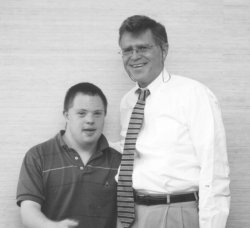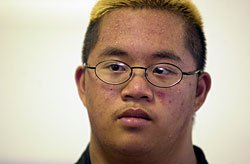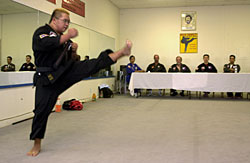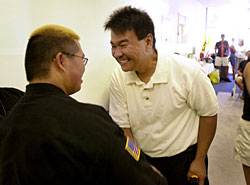|
Our next meeting will be in February 2003, so please join us December 8th for the Down Syndrome Association of Greater St. Louis Christmas party. See Regional Events below for details. If you would like to volunteer to help organize this event, contact Marc and Peggy Mitchell at 346-5628.
The past July issue, this issue and the forthcoming December issue are in tribute to Holly Wrobbel.
Following is update our group's recent activities:
Peggy Mitchell and Sue Brown have been elected to the Board of Directors of the Down Syndrome Association of Greater St. Louis. Peggy's responsibility is to report the happening in Illinois, strengthen the bonds between both groups, increase paid memberships and ensure that the Illinois meetings have speakers and continue to support families. Sue is the Family Support co-chair, which is in the process of updating and adding to the information packets that are available. Sue graduated from Lewis and Clark College with a degree as an Occupational Therapy Assistant and works in the schools and in Early Intervention as a therapist.
Victor Bishop gave a presentation on Early Literacy and Down Syndrome on July 24, to Dr. Debra Hoge's SIUE summer class: Introduction to Early Childhood Special Education, with the assistance of Holly, 2 years old, who superbly sight-read her flash cards for her father, Dr. E. Duff Wrobbel.
Mary Trudell will speak on positive and negative aspects of dealing with public school personnel on October 17 in a Community School Psychology Program class. Mary is also a full scholarship recipient from the State of Illinois to obtain a Bachelor's in Special Education.
Sue Brown was part of the parents' panel on October 7, What will we tell the kids? A STARNet workshop promoting a more inclusive social-educational environment.
|
 |
STARNet Region IV
December 4, Friday, 9:00 a.m. - 3:00 p.m. The Proactive Paraprofession. This workshop is geared towards teaming and building relationships within the pre-kindergarten through third grade setting. Participants will benefit most if they come with their team. This workshop will provide participants with some ideas on how to deal with difficult behavior, work with other students in the room, prompt students, and identify roles and responsibilities. Presenter: Denise Henry, MA, worked first as a paraprofessional in primary special education and then as a teacher. She is former consultant with Project CHOICES, a grant funded ISBE initiative that provides technical assistance to schools families, and communities across the state as the work to include children with disabilities in general education. Denise is now a resource specialist with STARNet Region IV. Location: John A. Logan College (Dining Room Annex) 310 W. Plaza Drive. Carterville, IL. Driving directions: (618) 985-5975. For further information call STARNet at 397-8930, ext. 166.
Regional Events
Sunday, December 8, 1:00 p.m - 4:00 p.m. Down Syndrome Association of Greater St. Louis Christmas Party. High Ridge Elks Club, 101 Old Hunning Road, High Ridge, MO. Directions: Highway 270 to Highway 30 (Gravois). West on Highway 30 to High Ridge Blvd. Right on High Ridge Blvd., Elks Club is on the left. Follow the signs!
Down Syndrome Articles
Student with disability meets college challenges by Beth Wohlberg. Pacesetter, Fall 2002, Vol. 25, Issue 3, page 7. Reprinted with permission from PACER Center Inc., Minneapolis, MN. (612) 827-2966. http://www.pacer.org. All rights reserved.
Nick Baltins ventured into new territory last year when he started college at National-Louis University outside of Chicago. It was the first time Nick left home for extended periods of time, roomed with someone his own age, and traveled to and from Minneapolis by himself. He learned new skills: balancing a checkbook, controlling his emotions, and making it to appointments on time.
|
Nick is also only the second person with Down syndrome to attend the university's Professional Assistant Center for Education (PACE) program, which is a two-year, post secondary education for young adults with learning disabilities. Students learn professional training for human services programs as well as independent living skills.
Nick's endeavor has clearly been a success—evident by Nick starting school a week early this September as an ambassador for first-year students who need help finding their way with new routines and around campus.
"I am so excited to go back," Nick said. "I will help people and show them around. They are so afraid—it is their first time going to college."
Nick understands how daunting it can feel to be a new student, but even so, he didn't let that get in the way of his independence last year. Nick took the train alone to visit his father back home in Minneapolis, traveled on the "el," or elevated, train around Chicago by himself, and limited his phone calls home.

|
Nick and Andy Baltins saw each other about once a month last school year, Nick's first at college near Chicago.
|
"We saw each other about one time a month," said Andy Baltins, Nick's father. "He like the train better than the airplane because he could travel by himself. He likes being independent. Nick set very defined rules—he called Wednesdays and Sundays but didn't want too much contact."
As part of his curriculum at school, Nick worked at several jobs, in which he learned about dealing with coworkers and being prompt. He worked with his professors on real-life problems, such as how to handle a difficult or uncomfortable conversation. Nick learned about living with a roommate who had different musical tastes and personal habits.
"We listened to each other's problems and then tried to express—not explode—our feelings," Nick said about his roommate and good friend.
His hard work has paid off, according to Andy. This summer, Nick organized his work and free time entirely by himself. He hired a tutor to keep up with schoolwork and taught karate a few nights a week. Last year, Andy scheduled most of Nick's summer activities.
After his second year of school, Nick will be able to work with faculty on independent living skills while renting an apartment with two roommates. He said he is still exploring his options after graduation, however, because "it is never easy to pay rent" and he is unsure of the kind of job he wants.
But Andy has a hunch that Nick will figure out what is best.
"Nick has been the leader," Andy said. "I must say I didn't have a vision 20 years ago that Nick would finish high school and go to college. Nick has set his own course.
Martial plan. Brandon Fullecido, born with Down syndrome, uses determination, courage and skill to earn a black belt by Cynthia Hubert - Bee Staff Writer, (916) 321-1082 or chubert@sacbee.com, September 14, 2002. Copyright © The Sacramento Bee.

|
Brandon's mother, Flora Fullecido, congratulates her son after he successfully tested for his black belt. Sacramento Bee/Brian Baer.
|
Brandon Fullecido's eyes are laser beams, focused on the body of a man twice his size. His arms are swords, slashing at the air. His bare feet are butterflies, dancing on the spongy floor.
"KeeeeeAiiiiii!" he shouts, kicking and twirling and jabbing at his opponent.
Thump. The big man hits the ground.
Brandon, 16, smiles shyly, sweat glistening on his brow, lips curling above the metal braces on his teeth. He has done it again. Another takedown. Another victory for a young man whose whole life has been about punching down obstacles.
"I am never afraid," Brandon declares.
It is a bold statement from a person with Down syndrome, a person doctors once said should live in an institution, a person who few dreamed could achieve the highest rank in martial arts.
On a recent Saturday afternoon, Brandon Fullecido earned his black belt in karate.
So much for the doubters.
Never mind that it took Brandon eight years, twice as long as most people, to perfect this artful form of defense. With the gentle encouragement of his parents, the patient guidance of his instructors and sheer determination to succeed, the teen who once had trouble making friends is now a role model for other young martial artists.
"I have been teaching for 42 years and I have never had a student as committed as Brandon," says Larry Reid, a bear of a man who runs a martial-arts school in Carmichael.
"I think about all our years with Brandon, all the challenges he has had, all the other kids who passed him by and got their belts before him. At times it was really hard on him. But he kept coming in here, and he never gave up. This kid just never gave up."
Brandon is living proof, says his father, that people with Down syndrome can achieve their dreams.
His story begins with a genetic quirk, a defect that affects some 5,000 babies each year in the United States. Down syndrome is the most common chromosomal cause of mental retardation. Children with the condition have distinct physical characteristics, including broad faces and flat noses, and generally develop more slowly than their peers. They also are prone to health problems including heart, breathing and eye ailments.
Brandon was 6 pounds, 9 ounces when he was born in San Diego, Robert and Flora Fullecido's second child. Their first, Jaclyn, was healthy, and Flora's pregnancy had been uneventful. But in his first months of life, Brandon's parents noticed the baby seemed lethargic, and his motor skills were lagging.
"We knew zero about Down syndrome," says Robert Fullecido, a soft-spoken computer security specialist. "We had a lot of denial. It took three genetic specialists and two general practitioners to convince us that this was what was happening."
Doctors recommended that Brandon be placed in an institution, the couple recall.
The very idea offended them.
"We never considered it," says Robert Fullecido, shaking his head. "Once we accepted what life had dealt to us, we decided to do everything we possibly could on Brandon's behalf. People kept telling us no, and we kept telling them yes."
They placed Brandon in infant and toddler programs to help him develop his motor and social skills, and give him a jump start on his education. They fought school systems for his inclusion in mainstream classes.
When he was 6, Brandon's family moved from Southern California to Antelope. By this time, he had become an angry little boy, painfully shy with other people and prone to disruptive outbursts.

|
Brandon Fullecido, 16, set a goal eight years ago to get his black belt in karate. Sacramento Bee/Brian Baer.
|

|
Brandon performs martial-arts moves during his black-belt test before a panel of master instructors. The 16-year-old has won many competitions in his age group. Sacramento Bee/Brian Baer.
|

|
Brandon Fullecido is greeted by his father, Robert, after Brandon's successful black-belt test. Sacramento Bee/Brian Baer
|
"He was trying to fit in, just to have friends," recalls his mother, a former teacher's assistant. "But he was not accepted. He was frustrated. Other kids were playing soccer and other team sports, but not him. I was feeling sad for him."
One thing did seem to calm Brandon and capture his imagination, however. "He started watching movies with Chuck Norris and Bruce Lee, and he was fascinated," Flora Fullecido says. "He started imitating their moves." Karate became something of an obsession for the boy.
Shortly after Brandon turned 8, his parents took him to the Reid Family martial arts center, hoping a karate class might help him control his temper and improve his concentration. Because the boy was a poor reader and communicated very little with words, Larry Reid was dubious. In his deep, gravelly voice, he told the Fullecidos he wanted to talk to the child alone.
"I took him aside, and I told him what the martial arts are about, how much work is required, that they should never be used in the wrong way," recalls Reid, whose wife, Linda, and son, Daren, also are instructors. Reid talked about leadership, courtesy, respect and discipline. Brandon sat in riveted silence.
When Reid finished, the boy offered only one comment. "I want to be a black belt," he said, looking straight into Reid's eyes. Reid, impressed with the boy's attitude and spirit, decided to help him work toward that goal.
"I never dreamed it would happen," Reid concedes. "But from that day forward, Brandon believed he could do it. There was absolutely no question in his mind."
Brandon began working out at the center three to five times a week with instructors and practiced at home. His form, power and speed slowly improved. So, too, did his confidence, control and social interactions. Brandon began enrolling in organized competitions.
Finally, Brandon was ready to compete for his black belt.
First he would have to pass a written test and write a thesis about the martial arts. Then he would demonstrate his technical skills in a grueling, hours-long session before five judges. So stressful is the physical portion of the event that some candidates black out or freeze, forgetting techniques they had previously perfected. Brandon's parents and instructors secretly worried whether he was up to the task.
Brandon struggled mightily with the written exam, barely passing, but made up for it with a moving personal essay about his lifelong desire for a black belt. Then, as his parents and instructors watched, he faced the judges.
They saw a stocky boy, just 5 feet tall and close to 160 pounds, with a buzz of brown hair tipped with blond highlights. Brandon looked poised and comfortable in his baggy cotton gi, or uniform.
The martial-arts center, filled with friends and relatives of the black-belt candidates, was silent, tinged with tension. But as soon as Brandon began performing the first of hundreds of moves, the nervousness melted away.
As the judges, all of them master instructors, watched and scribbled on notepads, Brandon demonstrated kicks and strikes and katas, or fluid, continuous movements. He sparred with two men who wore black belts.
"Everything is so sharp, so perfect," Linda Reid thought as she watched him perform. "He looks amazing."
Perspiration pooled beneath Brandon's tortoiseshell glasses and dripped down his face. But he never lost his focus.
After finishing his final moves, Brandon kneeled before the judges, along with two other black-belt candidates. With permission, he removed the brown belt around his waist and placed it to his left. Carefully, he replaced it with the black belt. Congratulations, the judges said, while his parents and instructors wept joyfully.
"You did it, son," Robert Fullecido said, shaking Brandon's hand. His mother gave him a hug.
The boy whom everyone doubted had proved them all wrong.
Now, having won trophies taller than himself, Brandon helps his sister Kaitlin, 10, hone her karate technique. He plays a little baseball with his father. He Rollerblades and swims. He attends mainstream classes at Woodcreek High School in Roseville. He has friends and admirers.
"Believe it or not, I like the attention," he says.
Next, Brandon hopes to be a karate instructor. "I would like to open my own studio," he confides softly.
To some, it seems improbable. Brandon's comprehension level remains at about the fifth-grade level, and he is still extraordinarily shy and reluctant to speak to strangers. But Brandon Fullecido owns a black belt in karate. Nothing seems impossible anymore.
Commentary by Dr. Nicholas Lennox, M B B S, B Med Sc, Dip Obs, FRACGP, Head, Developmental Disability Unit, Department of Public Health and Community Medicine, The University of Melbourne, Melbourne, Vic. E-Mail: n.lennox@spmed.uq.edu.au.
Clinical Case Review is reprinted from Modern Medicine of Australia, June 1997 with the permission of Kate Murchison, Chief Assistant Editor, Medicine Today.
Clinical problem
A 25-year-old man presents with a history of deteriorating function over the last five years. This has included a decrease in his vocabulary and use of words, and a loss of his ability to negotiate the geography of his community. Six months prior to presentation his mother had died. The man has Down syndrome, and apart from his recent deterioration he is otherwise well. Is this man demented, depressed or grieving? How should he be assessed and what investigations are appropriate?
Commentary
Although there is thought to be an association between dementia and Down syndrome, the dementia usually occurs in the fourth and fifth decades and would be very unlikely in a man of this age. However, it would be worth simply excluding this as a possibility once other causes of his deterioration have been assessed.
With the patient's history of deteriorating function, I would also look for any evidence of depression — in particular, the biological signs of depression (such as anorexia, weight loss, early morning waking, constipation) and also any signs of depressed mood. In people with intellectual disabilities it is not uncommon to find increasing levels of aggression and irritability associated with a major depressive disorder. As communication difficulties are common in such people, changes in behaviour are often a communication of their situation.
The death of the man's mother is a major event in his life. The symptoms he presents with may be his way of communicating his distress. The consequences of this major loss may not be just interpersonal, but may result in changes in his accommodation, a change in his primary caregiver, and major dislocation of the usual patterns and rhythms of his life. Adjusting to such changes can be a major challenge for anyone, including the person with an intellectual disability. Indeed, for people who have high dependency needs, a very limited social network and a limited ability to adjust to change, the consequences of the loss of a parent or sibling can be devastating.
It is important to attend to such a patient's need to undergo a healthy grieving process. This should include providing him or her with the opportunity to attend the funeral and associated gatherings, to visit the grave and to share feelings about the loss. If verbal communication is a problem, visual aids which graphically represent feelings, events and objects, such as COMPIC, can be used to facilitate the process of grieving.
Physical assessment should particularly include assessment for possible hypothyroidism (which is quite commonly seen in people with Down syndrome), screening for dementia and exclusion of any sensory deficits.
Referral for hearing and vision testing is essential, as neurosensory and conductive hearing losses are very common in people with Down syndrome, as are a whole range of ophthalmic disorders, including cataracts, myopia and keratoconus. Adult-onset epilepsy should be excluded as this is a common presentation of epilepsy in people with Down syndrome.
If the physical investigations are essentially normal and there is some indication of a depressive disorder, especially irritability with other features of depression, I would commence the patient on an SSRI rather than a tricyclic antidepressant. Tricyclic antidepressants can cause hypotension and anticholinergic side effects. These side effects may exacerbate the tendency of people with Down syndrome to have hypotension and dry skin.
Web Wanderings
URL: http://www.waisman.wisc.edu/news/chapman.html
Kids with Down syndrome learn language beyond adolescence by Emily Carlson (608) 262-9772, emilycarlson@facstaff.wisc.edu. Contact: Robin Chapman, (608) 263-5820, chapman@waisman.wisc.edu.
MADISON, WI, October 16, 2002 — Children with Down syndrome can face many challenges - health problems, hearing impairments and learning disabilities, including those affecting language development. While modern advances in medicine have improved the health of children with this disability, a concern remains about the development of communications skills among these children.
Countering the claim among researchers that language learning in children with Down syndrome ends during the teen-age years, a new study from the University of Wisconsin-Madison suggests that individuals with Down syndrome can benefit from language intervention programs during adolescence.
Down syndrome is a developmental disability resulting from an extra copy of chromosome 21, and it affects about 5,000 newborns in the United States every year. A century ago, most children with this disability reached the age of only 9; today, they live well beyond their 50s.
Most children begin learning language skills, such as grammar and speaking, at rapid rates early in their lives. Children with Down syndrome, however, typically experience delays in language development, learning more slowly and at varying rates.
"There's a fanning out of skills in individuals that isn't seen in normally developing children," explains Robin Chapman, the study's primary investigator and a professor emeritus of communicative disorders at UW-Madison's Waisman Center, a facility dedicated to advancing the understanding of developmental disabilities. For example, vocabulary learning may progress much more rapidly than the learning of sentence structure, she says.
Though all these skills continue to improve throughout childhood, Chapman says that some researchers have claimed that the skills begin to plateau as a child with Down syndrome reaches adolescence. As a result of this claim, she notes, educational opportunities for teen-agers with this disability generally shift away from language learning.
Chapman's study, on other hand, shows that certain language skills continue to improve well beyond the teen-age years, suggesting that adolescents with Down syndrome should continue programs for language learning.
For the last six years, Chapman and her colleagues have charted the trajectory of learning skills and memory abilities in 31 individuals with Down syndrome who were ages 5-20 at the study's start. Through comprehension tests and storytelling tasks, they measured each person's ability to understand complex grammar (language comprehension) and his or her ability to speak it (language expression).
While Chapman found that some language skills may stop developing as these children reach late adolescence, she also found that language expression skills continue to improve well into young adulthood - and that their development depends on the development of language comprehension skills, which do tend to plateau.
The longitudinal pattern of language learning in individuals with Down syndrome, says Chapman, shows that language comprehension skills quickly develop during childhood, but that development slows down as the child reaches the teen-age years.
Language expression skills run a different course. "The biggest gap in language learning occurs between language comprehension and expression," she says. But, unlike the other set, expression skills continue to improve throughout adolescence.
Chapman found, however, that the continued development of language expression depends on at least maintaining comprehension skills.
"The rate of change in expressive learning skills," she says, "is predicted by the rate of change in language comprehension skills." For example, if an adolescent acquires the ability to understand complex grammar more slowly, he will also acquire the ability to speak that grammar more slowly.
These findings, says Chapman, point to the importance of continuing language intervention during the teen-age years: "The study's findings suggest that there should continue to be language work in both comprehension and expression throughout teen-age and young adult years."
Furthermore, Chapman suggests that, because of the gap in the development of the two skill sets, language instruction should alternate its emphasis between them.
Father's Journal
Inclusion
Emmanuel is fortunate because he is included and did not have to die before he was born, other children with Down syndrome had no choice but to be dismembered.
|
|
"Kids with Down syndrome can accomplish a lot," Chapman says. "Think of Chris Burke who starred in the television show, 'Life Goes On.' We need to maximize the opportunities so they can accomplish even more."
The study was funded by the National Institutes of Health and the National Down Syndrome Society.
The findings are published in the October issue of the Journal of Speech, Language and Hearing Research.




